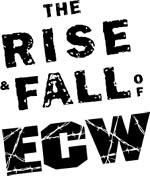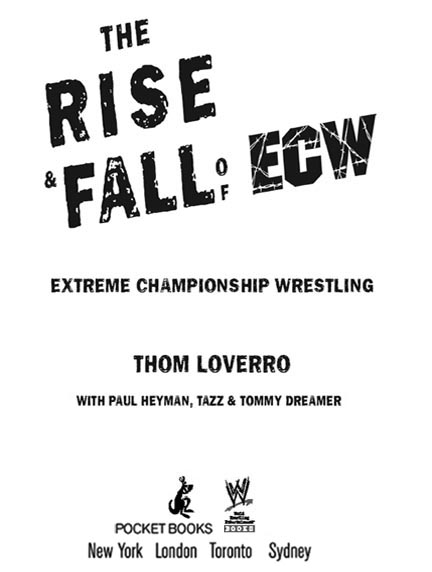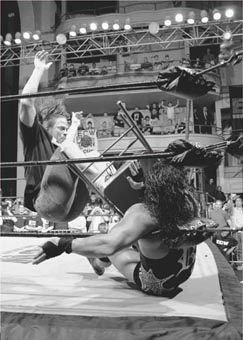The Rise & Fall of ECW
Read The Rise & Fall of ECW Online
Authors: Tazz Paul Heyman Thom Loverro,Tommy Dreamer




 | POCKET BOOKS, a division of Simon & Schuster, Inc. 1230 Avenue of the Americas, New York, NY 10020 |
Copyright © 2006 by World Wrestling Entertainment, Inc. All Rights Reserved.
World Wrestling Entertainment, the names of all World Wrestling Entertainment televised and live programming, talent names, images, likenesses, slogans and wrestling moves, and all World Wrestling Entertainment logos and trademarks are the exclusive property of World Wrestling Entertainment, Inc. Nothing in this book may be reproduced in any manner without the express written consent of World Wrestling Entertainment, Inc.
This book is a publication of Pocket Books, a division of Simon & Schuster, Inc., under exclusive license from World Wrestling Entertainment, Inc.
Photos
vi,
7,
184,
186
Copyright © 2005 World Wrestling Entertainment, Inc.
All Rights Reserved.
All other photos Courtesy of
Pro Wrestling Illustrated
Photographs.
All rights reserved, including the right to reproduce this book or portions thereof in any form whatsoever. For information address Pocket Books, 1230 Avenue of the Americas, New York, NY 10020
The Library of Congress has cataloged the hardcover edition as follows:
Loverro, Thom.
The rise & fall of ECW: Extreme Championship Wrestling / Thom Loverro with Paul Heyman, Tazz, Tommy Dreamer.
p. cm.
1. Extreme Championship Wrestling—History. 2. Wrestling—History. 3. Wrestlers—History. I. Title: Rise and fall of Extreme Championship Wrestling. II. Heyman, Paul. III. Tazz. IV. Tommy Dreamer. V. Title.
GV1195.L68 2006
796.81209—dc22 2006041619
ISBN: 1-4165-6156-0
ISBN: 978-1-4165-6156-9
POCKET and colophon are registered trademarks of Simon & Schuster, Inc.
Designed by Jan Pisciotta
Visit us on the World Wide Web:
To Paul.
Thanks.

I
f you had to select one word to describe what Extreme Championship Wrestling—ECW—was, it would have to be passion.
Long-lasting passion, if you happened to be at the Hammerstein Ballroom in New York on June 12, 2005.
What happened that night was a remarkable tribute to everything that made ECW such a passionate entertainment experience for everyone involved—the wrestlers, the support staff, and the fans alike.
It was
ECW One Night Stand,
a Pay-Per-View that paid tribute to ECW, and it was as if the year was 1995 again and we were back at the old bingo hall that served as the ECW Arena in South Philadelphia.
It had been four years since ECW had its last event, a show in Pine Bluff, Arkansas. Yet a sold-out crowd paying top dollar packed the ballroom on this June night to welcome back an old friend, and many more paid to watch it on Pay-Per-View.
From the moment Joey Styles came out to the ring to kick off the festivities, it was “Oh, my God!”—Styles’s signature call as the ECW television announcer—from the first bell to the end of the final match. Fans were in the throes of what was basically a three-hour passion play, screaming at the top of their lungs, “ECW! ECW!” as if it was the response in a gospel mass.
They welcomed back many of their old friends—The Blue Meanie, Lance Storm, Justin Credible, Mikey Whipwreck, Sabu, Rob Van Dam, Francine—and many others who had given so much of their hearts and bodies to ECW, and still had something left to give to fans on this night, whether it was action in the ring—sometimes resorting to chairs, tables, ladders, and even cheese graters—or their words to the crowd. Van Dam, for example, told the crowd his time in ECW was the best of his career. Many other wrestlers who spent time in the promotion will say the same thing.
“There was no other experience like it,” Francine says. “It was the best experience of my life. I would have worked there until I couldn’t work anymore. I didn’t care what offer came at me. I would have never left Paul and ECW. I was offered to leave a couple of times, and I would not go. I would have died working for that company.”
That sort of passion was played out in the ring between wrestlers and in the crowd among the fans on a regular basis during ECW’s glory days, and the fans tapped into that passion and showed their loyalty to ECW by their reaction to
One Night Stand.
Of course, the “mad scientist” behind ECW was there as well, Paul Heyman, who gave a great shoot speech about what made ECW so special, and the fans showed their appreciation for creating this force of nature that had a huge impact on the wrestling industry.
A lot had happened since Heyman was invited in 1993 into this small Philadelphia promotion, which at the time was not much beyond a sports bar show. He had come into the right place at the right time to take his vision of wrestling and turn it into a reality. Three years later, Heyman had turned this tiny outfit into the white-hot promotion of the industry. It would eventually burn out, but not before becoming part of the cultural landscape for a generation of wrestling fans.
“If somebody got a ring and a show together, and Tommy Dreamer made a call saying, ‘Guys, we’re getting the band back together for a night in, let’s say, Peoria,’ guys would show up and wrestle like it was
WrestleMania,”
observes Mike “Super Nova” Bucci, who was part of Raven’s Flock and would team up with Stevie Richards and The Blue Meanie to form the Blue World Order.
ECW was just like that—it created memories to cherish for both wrestlers and fans.
Thom Loverro
The Roots of ECW
T
o look at the history of ECW, it is important first to examine the history of the business itself, and the steps that led to the ECW phenomenon. It is particularly important in the context of the allure of ECW, because a good part of the attraction of the promotion was that it bucked wrestling tradition, going out of its way to distance itself from the practices of the past.
Wrestling was one of the first competitions men engaged in. They didn’t need any tools or equipment, nothing except their hands to lock up with each other and start wrestling. Cave drawings of wrestling matches dating back an estimated 15,000 years were found in France, and early Babylonian and Egyptian reliefs show holds that are still used in modern times. Wrestling was one of the most popular sporting events in Greek society and was considered among the elite competitions in the early Olympics. The Romans helped maintain the tradition of wrestling, and it continued through the Middle Ages throughout Europe and the Far East, particularly as sporting entertainment for royal families.
When settlers came to America from England, they brought wrestling with them as part of their culture, but it was also already here, practiced among the Native Americans. It became part of the new American culture, and became more popular as German and Irish immigrants arrived in the new country. It began to take form as a professional spectator event at local carnivals, where a few wrestlers would fight each other and also challenge the crowd to see if any local tough guys could last, let’s say, fifteen minutes in the ring with one of the professionals.
Even as professional wrestling grew to be a major urban spectator event in the twentieth century, it was still making the rounds on the carnival circuit in small towns, particularly in the Midwest. Some of the more popular wrestlers of the 1960s and 1970s even got their start in the carny shows. The legendary Sputnik Monroe tells this tale about his days wrestling at traveling carnivals and the wild and woolly situations wrestlers could find themselves in:
“One time I had a guy down with his arm up behind him, and I told him to give up. He said, ‘I can’t.’ He didn’t say it loud enough for everyone to hear, so I said again, ‘Give up or I’ll break your arm.’ Everyone heard me, including the local sheriff, who threatened to shoot me if I broke this guy’s arm. I said, ‘He’s gonna give up, or I’ll hold him here until he starves to death.’ I held him down until the sheriff counted to three.”
Those carny roots are still deeply ingrained in the business, even today, as terms from those raucous days—
work, shoot, angle, mark,
and
kayfabe
—are still used today in the business.
The growth of the business, though, took place when contests started to take place in arenas and stadiums in big cities, the personalities in the business began getting acclaim and the attention of the press, and titles were created and recognized. The first generally recognized modern pro wrestling match came in Cleveland at the Central Armory in 1897, when Tom Jenkins defeated Martin “Farmer” Burns in two falls to win the United States championship. Burns would remain a major figure in the early history of wrestling, becoming a mentor for a young up-and-coming wrestling star named Frank Gotch, who excelled at the “catch-as-catch-can” wrestling style. In 1904, Gotch won the United States heavyweight title by defeating Jenkins, and four years later, perhaps the first superstar match in professional wrestling took place, between Gotch and the man who had become a European wrestling star, George Hackenschmidt, a wrestler with remarkable upper body strength who came into the bout reportedly undefeated.
The match, which took place before a large crowd at Dexter Park in Chicago, became one of the legendary contests in wrestling history, drawing national attention. According to reports, the match lasted more than two hours before Hackenschmidt finally surrendered. The
New York Times,
which covered the match, reported that Gotch “side-stepped, roughed his man’s features with his knuckles, butted him under the chin, and generally worsted Hackenschmidt until the foreigner was at a loss how to proceed.” Of course, since this was wrestling, there was controversy. After the match, Hackenschmidt charged that Gotch had soaked his body in oil, and that Gotch “dug his nails into my face, tried to pull my ear off, and poked his thumb into my eye.”
Sounds like an ECW match, without the tables and chairs.
Gotch and Hackenschmidt met in a rematch in 1911, again in Chicago, at Comiskey Park, where another large crowd was on hand to watch Gotch win again, and again there was controversy and the sort of behind-the-scenes business that would always surround professional wrestling and eventually turn the sport into its current acknowledged status as scripted entertainment. Hackenschmidt had an injured knee and wanted to cancel the match. But it was such a highly anticipated event that promoters tried to salvage it with an agreement between the two wrestlers whereby Hackenschmidt would be allowed to win one of the three falls to save his reputation, but would go down in defeat to Gotch in the best two out of three falls match. However, Gotch is supposed to have double-crossed Hackenschmidt, winning the match in two straight falls. Gotch kept the United States title until he retired in 1913.
The next big star in professional wrestling was a Greek-born good-looking strongman named Jim Londos. He would be one of the stars to bridge the era where “shoot” matches—legitimate contests—began to disappear, and performers like Londos began to dominate the scene. He remained the business’s biggest draw during the golden era of sport in this country, in the days of Babe Ruth, Jack Dempsey, and Bobby Jones. Londos was the first NWA heavyweight champion.
As football began to emerge as a popular sport, there were a number of professional players, who crossed over and wrestled, the best known being Hall of Famer Bronco Nagurski, whom Londos met in the ring. The other big star during from the 1920s and 1930s was Londos’s nemesis, Ed “Strangler” Lewis, who worked for midwestern promoters and often defeated Londos, who represented the eastern promoters. Lewis, one of wrestling’s biggest draws, had a public feud with Dempsey, demanding a match against the boxing champion. It never happened, but Dempsey did once referee a match at Chicago’s Wrigley Field between Lewis, whose use of the headlock was so effective and controversial that the New York State Assembly tried to ban it, and Londos.
Former Dartmouth football star Gus Sonnenberg defeated Lewis for the world heavyweight championship in 1932, and Sonnenberg’s style—he was known for the flying tackle—is believed to have started the trend toward more acrobatic showmanship and less use of strength and pure wrestling. Five years later, a young wrestler named Lou Thesz—whom Lewis would later train and manage—won the first of seven world heavyweight championships. Thesz, a well-known catch wrestler, or hooker, would go on to wrestle until 1990.
While all this was going on inside the ring, there was a man named Jess McMahon who was promoting a number of sporting events, including boxing at Madison Square Garden, and, among other ventures with his brother Ed, also owned several Negro League baseball teams, including the famous Lincoln Giants in New York. He would eventually branch out into promoting wrestling, and that part of the business would be nurtured by his son, Vincent Jess McMahon, who would eventually change the business and become one of the most influential promoters in the history of professional wrestling. At the same time, another wrestling promotion in North Carolina began to take shape—Jim Crockett Promotions. Other promotions popped up across the country, and eventually the most powerful ones divided the United States up into regions to conduct the business of wrestling, under the auspices of the National Wrestling Alliance (NWA), a group of independent professional wrestling promotions formed in 1948 under the direction of St. Louis promoter Sam Muchnick.
Another promoter who emerged as a force in New York was Toots Mondt, who would join forces with a young Vincent Jess McMahon to establish the dominant wrestling promotion in the northeastern United States, called Capitol Sports, in 1948, and would also join with the NWA that same pivotal year in the business.
Like most spectator events, wrestling suffered during the war years of the 1940s, but bounced back strong in the 1950s because it turned out to be the perfect show for the new medium that was sweeping the nation—television. Wrestling was made for television, and stars like Gorgeous George and Antonino Rocca emerged as TV stars. Vince McMahon, who saw the power of television, used it to syndicate wrestling shows throughout the northeastern United States, and eventually broke away from the NWA and changed the name of Capitol Sports Corporation to the World Wide Wrestling Federation (WWWF) in 1963. That same year, “Nature Boy” Buddy Rogers lost the WWWF heavyweight title to a young Italian star named Bruno Sammartino, getting pinned in less than a minute at Madison Square Garden, and a new era in wrestling was born.
While the WWWF grew in popularity under Vince McMahon, with Sammartino as his champion, wrestling flourished in other parts of the country as well. Amateur wrestling great Verne Gagne led the newly formed American Wrestling Association (AWA) in the midwest, featuring legendary wrestlers such as Dick the Bruiser and the Original Sheik (who was also a promoter in the Detroit area), while on the West Coast and in the South, various NWA-linked promotions were home to legends such as Freddie Blassie, Pat Patterson, Dory Funk, and Sputnik Monroe.
While the WWWF grew, Vincent Kennedy McMahon began working in the promotion and would eventually take it over from his father in 1982, in a move that would change the landscape of the business in ways that no one had ever seen before. Vince McMahon had a vision for his promotion that went far beyond the traditional way of doing business. He began expanding into other territories, turning the promotion into a national one, and took the use of television and the entertainment value of wrestling to a new level.
The WWWF became simply the World Wrestling Federation in 1979, and fell under the auspices of Titan Sports when Vincent K. McMahon took over. He had a plan to take wrestling into mainstream entertainment, and one vehicle for doing this was an idea for a mega wrestling show known as
WrestleMania.
On March 31, 1985, Vince McMahon put everything he had into one of the most successful ventures in the history of the business:
WrestleMania
at Madison Square Garden. The show featured matches between some of the greatest wrestlers of the era, including Andre the Giant vs. Big John Studd, and a main event consisting of Hulk Hogan and his tag-team partner, the actor Mr. T, who had played Clubber Lang in the film
Rocky III
—the same movie in which Hogan raised his profile beyond wrestling circles by playing a wrestling character named Thunderlips—against “Mr. Wonderful” Paul Orndorff and “Rowdy” Roddy Piper. McMahon added all sorts of entertainment touches that attracted new fans: baseball manager Billy Martin was the guest ring announcer, Liberace was the guest timekeeper, and Muhammad Ali was the guest referee. Pop singer Cyndi Lauper was also part of the show, helping Wendi Richter win the World Wrestling Federation Women’s Championship from the Fabulous Moolah. In the main event, Hogan and Mr. T won, and Hogan was on his way to becoming one of the most well known and popular wrestlers in the history of the business.
WrestleMania
became an annual live Pay-Per-View event that set the standard for the new era of wrestling, and spawned numerous other wrestling Pay-Per-View events.
